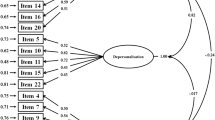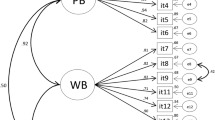Abstract
This study assessed the validity and reliability of Maslach Burnout Inventory-Human Services Survey (MBI-HSS) among Sri Lankan nursing officers. Although the factorial structure and reliability of the MBI-HSS is established across different countries and cultures there is minimal research on burnout or its measurement instruments in South Asian settings. The pre-tested Sinhala version of MBI-HSS was administered to a simple random sample of 191 nursing officers employed in a tertiary care hospital in Colombo. Confirmatory factor analysis was used to assess the construct validity of the hypothesized three-factor (emotional exhaustion, depersonalization and reduced personal accomplishment) structure. A three-factor model fitted the data better than a one-factor or a two-factor model. Two items (4 and 13) were identified as having poor psychometric properties. Deletion of Item 4 resulted in the best fitting model. A modified version of the Sinhala MBI-HSS without item 4 seems to be a highly suitable instrument to assess burnout among Sri Lankan nursing officers.

Similar content being viewed by others
References
Arbuckle, J., & Wothke, W. (1999). Amos 4.0 user’s guide. Chicago: Small Waters Corporation.
Beckstead, J. W. (2002). Confirmatory factor analysis of the Maslach Burnout Inventory among Florida nurses. International Journal of Nursing Studies, 39(8), 785–792.
Bentler, P. M. (1990). Comparative fit indeces in structural models. Psychological Bulletin, 107(2), 238–246.
Bourbonnais, R. M. (1998). Job strain, psychological distress and burnout in nurses. American Journal of Industrial Medicine, 34(10), 20–28.
Brown, T. A. (2006). Confirmatory factor analysis for applied research. New York: Guilford.
Brown, M. W., & Cudeck, R. (1993). Alternate ways of assessing model fit. In A. Bollen & J. S. Long (Eds.), Testing structural equation models. Newbury Park: Sage.
Burke, R. J., Greenglass, E., & Schwarzer, R. (1996). Predicting teacher burnout over time: effects of work stress, social support and self doubts on burnout. Anxiety, Stress and Coping, 9(3), 261–275.
Chau-wai, E., & Tang, C. S. (2003). The role of individual, interpersonal and organizational factors in mitigating burnout among elderly Chinese volunteers. International Journal of Geriatric Psychiatry, 18(9), 795–802.
Cherniss, C. (1999). Beyond burnout: helping teachers, nurses, therapists, and lawyers recover from stress and disillusionment. New York: Routledge.
Cocco, E., Gatti, M., de Mendonca Lima, C. A., & Camus, V. (2003). A comparative study of stress and burnout among staff caregivers in nursing homes and acute geriatric wards. International Journal of Geriatric Psychiatry, 18(1), 78–85.
Cordes, C. L., & Dougherty, T. W. (1993). A review and an integration of research on job burnout. The Academy of Management Review, 18(4), 621–659.
Demerouti, E., Bakker, A. B., Nachreiner, F., & Schaufeli, W. B. (2000). A model of burnout and life satisfaction amongst nurses. Journal of Advanced Nursing, 32(2), 454–464.
Duquette, A., Sandhu, B. K., & Beaudet, L. (1994). Factors related to nursing burnout. Issues in Mental Health Nursing, 15(4), 337–358.
Engelbrecht, M. C., Bester, C. L., Van Den Berg, H., & Van Rensberg, H. C. J. (2008). A study of predictors and levels of burnout: The case of professional nurses in primary health care facilities in the free state. South African Journal of economics, 76(S1), S15–S27.
Evans, B., & Fischer, D. (1993). The nature of burnout: a study of the three-factor model of burnout in human service and non-human service samples. Journal of Occupational and Organizational Psychology, 66(1), 29–38.
Freudenberger, H. J. (1974). Staff burnout. Journal of Social Issues, 30(1), 159–165.
Gil-Monte, P. R. (2005). Factorial validity of the Maslach burnout Inventory (MBI-HSS) among Spanish professionals. Revista de Saúde Pública, 39(1), 1–8.
Gorter, R. C., Albrecht, G., Hoogstraten, J., & Eijkman, M. A. J. (1999). Factorial validity of the Maslach burnout inventoryÐDutch version (MBI-NL) among dentists. Journal of Organizational Behavior, 20(2), 209–217.
Gundersen, L. (2001). Physician burnout. Annals of Internal Medicine, 135(2), 145–148.
Halbesleben, J., & Demerouti, E. (2005). The construct validity of an alternative measure of burnout: investigating the English translation of the Oldenburg Burnout Inventory. Work and Stress, 19(3), 208–220.
Hannigan, B., Edwards, D., Coyle, D., Fothergill, A., & Burnard, P. (2000). Burnout in community mental health nurses: findings from the all-Wales stress study. Journal of Psychiatric and Mental Health Nursing, 7(2), 127–134.
Hastings, R. P., Horne, S., & Mitchell, G. (2004). Burnout in direct care staff in intellectual disability services: a factor analytic study of the Maslach Burnout Inventory. Journal of Intellectual Disability Research, 48(3), 268–273.
Hu, L. T., & Bentler, P. M. (1999). Cutoff criteria for fit indices in covariance structural analysis: conventional criteria vs new alternatives. Stuctural Equation Modeling, 6(1), 1–55.
Huda, B. Z., Rusli, B. N., Naing, L., Winn, T., Tengku, M. A., & Rampal, K. G. (2004). Job Strain and its Associated Factors among Lecturers in the School of Medical Sciences, Universiti Sains Malaysia and Faculty of Medicine, Universiti Kebangsaan Malaysia. Asia-Pacific Journal of Public Health, 16(1), 32–40.
Hue, L., & Bentler, P. M. (1995). Evaluating model fit. In R. H. Hoyle (Ed.), Structural equation modelling - concepts, issues and applications. California: Sage.
Ilhan, M. N., Durukan, E., Taner, E., et al. (2008). Burnout and its correlates among nursing staff: questonnaire survey. Journal of Advanced Nursing, 61(1), 100–106.
Joreskog, K. G., & Sorbom, D. (1996). LISREL 8: user’s reference guide. Chicago: Scientific Software International Inc.
Kalliath, T. J., O’Driscoll, M. P., Gillespie, D. F., & Bluedorn, A. C. (2000). A test of the Maslach Burnout Inventory in three samples of healthcare professionals. Work and Stress, 14(1), 35–50.
Kanste, O., Miettunen, J., & Kyngäs, H. (2006). Factor structure of the Maslach Burnout Inventory among Finnish nursing staff. Nursing and Health Sciences, 8(4), 201–207.
Kristensen, T. S., Borritz, M., Villadsen, E., & Christensen, K. B. (2005). The Copenhagen burnout inventory: a new tool for the assessment of burnout. Work and Stress, 19(3), 192–207.
Lee, R. T., & Ashforth, B. E. (1990). On the meaning of Maslach’s three dimensions of burnout. Journal of Applied Psychology, 75(6), 743–747.
MacCallum, R. C., Widaman, K. F., Zhang, S., & Hong, S. (1999). Sample size in factor analysis. Psychological Methods, 4(1), 84–99.
Mardia, K. V. (1970). Measures of multivariate skewness and kurtosis with applications. Biometrika, 57(3), 519–530.
Maslach, C., & Jackson, S. E. (1981). The measurement of experienced burnout. Journal of Occupational Behavior, 2(2), 99–113.
Maslach, C., Jackson, S. E., & Leiter, M. P. (1996). Maslach burnout inventory (3rd ed.). Palo Alto: Consulting Psychologists Press.
Maslach, C., Schaufeli, W. B., & Leiter, M. P. (2001). Job burnout. Annual Review of Psychology, 52, 397–422.
Nunnally, J. C., & Bernstein, I. H. (1994). Psychometric theory. USA: McGraw-Hill Inc.
Onder, C., & Basim, N. (2008). Examination of developmental models of occupational burnout using burnout profiles of nurses. Journal of Advanced Nursing, 64(5), 514–523.
Payne, N. (2000). Occupational stressors and coping as determinants of burnout among female hospice nurses. Journal of Advanced Nursing, 33(3), 296–306.
Phoon, W. O. (1989). Epidemiological transition in Asian Countries and related health policy issues. Asia-Pacific Journal of Public Health, 3(2), 139–144.
Pines, A., & Aronson, E. (1988). Career burnout: causes and cures. New York: Free Press.
Poncet, M. C., Toullic, P., Papazian, L., et al. (2007). Burnout syndrome in critical care nursing staff. American Journal of Respiratory and Critical Care Medicine, 175(7), 698–704.
Potter, C. (2006). To what extent do nurses and physicians working within the emergency department experience burnout: a review of the literature. Australasian Emergency Nursing Journal, 9(1), 57–64.
Ramirez, A. J., Graham, J., Richards, M. A., Cull, A., Gregory, W. M., & Leaning, M. S. (1995). Burnout and psychiatric disorder among cancer clinicians. British Journal of Cancer, 71(6), 1263–1269.
Richardsen, A. M., & Martinussen, M. (2004). The Maslach burnout inventory: factorial validity and consistency across occupational groups in Norway. Journal of Occupational and Organizational Psychology, 77(3), 377–384.
Sahraian, A., Fazelzadeh, A., Mehdizadeh, A. R., et al. (2008). Burnout in hospital nurses: a comparison of internal, surgery, psychiatry and burns wards. International Nursing Review, 55(1), 62–67.
Sasaki, M., Kitaoka-Higashiguchi, K., Morikawa, Y., & Nakagawa, H. (2009). Relationship between stress, coping and burnout in Japanese Hospital nurses. Journal of Nursing Management, 17(3), 359–365.
Schaufeli, W. B. (2003). Past performance and future perspectives of burnout research. SA Journal of Industrial Psychology, 29(4), 1–15.
Schaufeli, W. B., & Buunk, B. P. (2003). The Handbook of Work and Health Psychology. Wiley.
Schaufeli, W. B., & van Dierendonck, B. (1993). The construct validity of two burnout measures. Journal of Organizational Behaviour, 14, 631–647.
Tabachnik, B. J., & Fidel, L. S. (1993). Using multivariate statistics. London: Harper & Row.
Tang, C. S.-K. (1998). Assessment of burnout for Chinese human service professionals: a study of factorial validity and invariance. Journal of Clinical Psychology, 54(1), 55–58.
Taris, T. W., Schreurs, J. G., & Schaufeli, W. B. (1999). Construct validity of the Maslach burnout inventory - general survey: a two-sample examination of its factor structure and correlates. Work and Stress, 13(3), 223–237.
Acknowledgements
Authors wish to acknowledge the administrators and nursing staff of North Colombo Teaching Hospital, Ragama, Sri Lanka for their support and participation. This research was funded by the World Health Organization (Project No: APW SE SRL PHE 001 / RB 07 / ER 2.1.5). The excellent comments provided by the anonymous reviewer are also appreciated.
Author information
Authors and Affiliations
Corresponding author
Additional information
This research was funded by the World Health Organization (Project No: APW SE SRL PHE 001 / RB 07 / ER 2.1.5)
Rights and permissions
About this article
Cite this article
Samaranayake, D.B.D.L., De A. Seneviratne, S.R. Validity of the Maslach Burnout Inventory – Human Services Survey among Sri Lankan Nursing Officers. Psychol Stud 57, 101–111 (2012). https://doi.org/10.1007/s12646-011-0135-5
Received:
Accepted:
Published:
Issue Date:
DOI: https://doi.org/10.1007/s12646-011-0135-5




